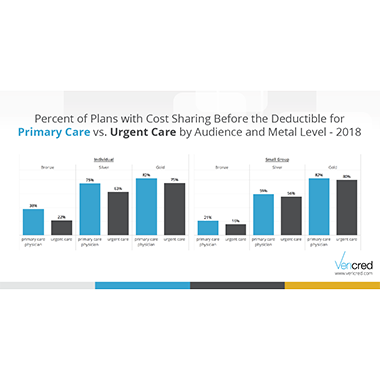Ideon Blog
October 30, 2018
By: Ideon
VeriStat: Cost Sharing Before the Deductible for Primary Care vs. Urgent Care

**Ideon is the company formerly known as Vericred. Vericred began operating as Ideon on May 18, 2022.**
In our last series of blog posts, we showed that health insurance carriers are becoming increasingly more likely to offer generous benefits for urgent care compared to the emergency room. While urgent care was conceived as a more convenient and lower cost alternative to the emergency room, it is also being used as an alternative to primary care—particularly, as a recent survey shows, by millennials. In this Veristat post, we will investigate cost sharing for urgent care compared to primary care.
The data science team at Vericred analyzed the benefit designs for health insurance plans on the individual and small group ACA markets to study the difference in how the costs for primary care and urgent care are split between individuals and their health insurance companies. The results show that for both primary care and urgent care, most silver and gold plans share the cost before the deductible, while most bronze plans do not. For all three metal levels, primary care is somewhat more likely to be covered before the deductible than is urgent care. This difference is larger for bronze plans than for silver and gold and larger for the individual market than the small group market. Across all three metal levels, the most common type of cost sharing for both benefits is a copay regardless of whether the deductible has been met; on the individual market, the median copays are $30 for primary care and $75 for urgent care.
While cost sharing is somewhat more generous for primary care than urgent care, there is a much smaller difference between these benefits than we previously found for urgent care vs. the emergency room. The way health insurance carriers structure their benefits influences the way their beneficiaries use the healthcare system. It is worth asking whether the difference between cost sharing for primary care and urgent care is slight enough to reinforce the growing shift towards urgent care as an alternative to having a regular doctor. While urgent care has some advantages, including extended hours for patients who may be unable to take time off work, using it as an alternative to a regular doctor leads to a more fragmented pattern of care. Health insurance carriers should consider how their benefit structures incentivize beneficiaries’ behaviors and how these behaviors will affect health.



